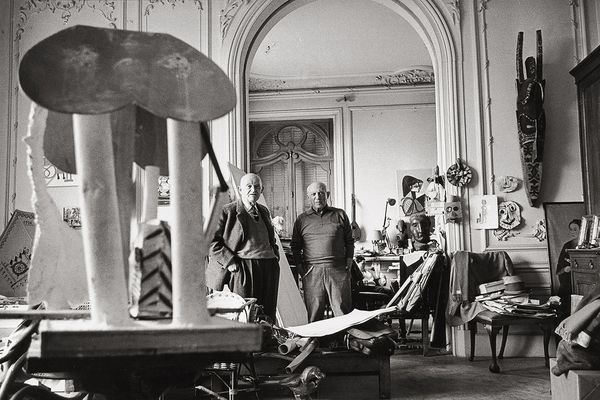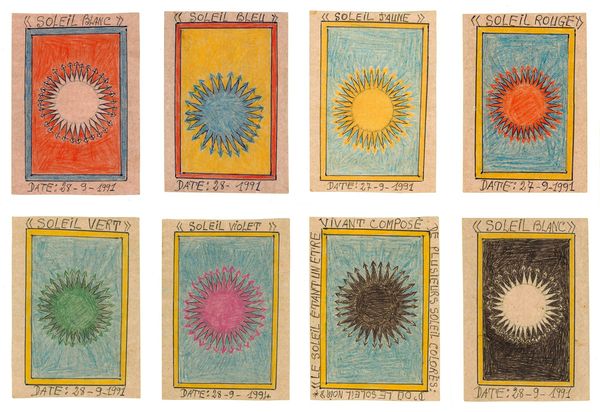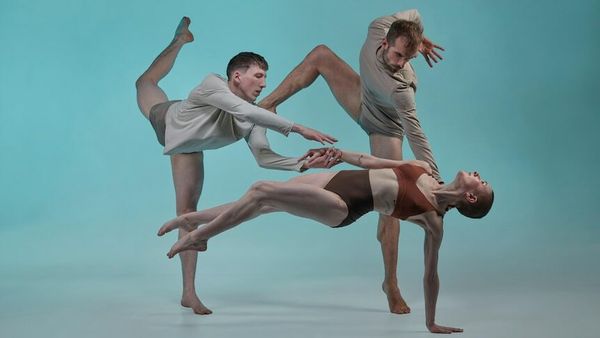Art galleries are places of splendour, home to things that can amaze, inspire and challenge you, fuel your imagination, and expand your view of the world. For some people, anyway.
For others, better words to describe a gallery might include: exhausting, perplexing, intimidating, irrelevant, and dare we say it, boring.
Here are six simple tips to make your next visit more fun, and help you look at art in a way that’s meaningful to you.
Don't try to see everything
When you step inside a gallery, you can feel pressure to see every single thing – room after room after room – and when you stagger out a few hours later you're completely spent.
Imagine if we did the same thing at the cinema – it makes no sense!
Justin Paton, the head curator of international art at the Art Gallery of New South Wales, says there's no shame in only looking at the things that really grab your attention.
"I think you walk through openly, you walk through curiously, you walk through with your antennae up," he told ABC RN's The Art Show.
"Look for that physical response — it might be adoration, it might be arousal, it might be revulsion.
"Those bodily cues, those ungovernable responses, are exactly what should make us look twice, make us look a third time.
"See what the wall label says about it, and if that doesn't correspond with the way you're feeling about it, look again, go and find out more."
You might pick one or two things in each room to look at (be ruthless!), or focus your visit on a special exhibition or one part of a permanent collection.
There's also the option of visiting smaller local galleries rather than a major institution.
Slow your roll
How long would you say you usually look at a piece of art? Studies have found many people move on after less than 30 seconds.
When you're not rushing through trying to see everything, you can afford to slow down.
"If you spend good time with one work it is infinitely more valuable than doing a grainy tour of a museum and coming out exhausted," Paton says.
"A great painting will flip switches and unlatch thoughts."
You might even try 'slow looking', an approach that involves spending about 10 minutes getting to know a work in detail.
Don't worry about what you're meant to see — look for your own connection. What do you notice? What does the work make you think of? How does it make you feel?
Adam Worrall, the new director of the Museum and Art Gallery of the Northern Territory (MAGNT), home of the annual National Aboriginal and Torres Strait Islander Art Awards exhibition, says he often sees the impact art can have on people.
"An artwork can change somebody's opinion about something, or somebody can have a real reaction, or feel a real relationship, or have an emotional experience — maybe because something is so beautiful, or unexpected, or sometimes even a bit scary or confronting," he says.
"There are no right or wrong answers. Just find something you respond to and work out: why did this thing attract me? It really is that simple."
Get to know the art
Postpone the impulse to form an opinion too quickly. You can go deeper than 'I love it' or 'I hate it' or 'Couldn't a child do this?'
"It's nice to think about artworks as you would think about people: not rushing into a judgement too fast," says Paton.
Paton, who is also the author of the book How to Look at a Painting, suggests asking yourself the following questions — which apply equally to sculpture, photography and textiles: "How is it structured? What are the proportions? What's the texture? What's the heft of this thing? Is it inviting me in quietly or is it pushing me back on my heels? Is it yelling at me in a loud voice, or is it doing something more subtle or musical?"
Reading the labels beside each work can be helpful – and don't skip the children's labels! Art historian Mary McGillivray, who has amassed a huge following on TikTok as _theiconoclass, says these are often more interesting and accessible.
Kids’ labels are usually written by education staff, whose job it is to make things interesting for students, and often include simple questions to help you relate to the work – such as, “Which colours do you like best?” or “What personality do you think this person would have?” or even “Would this chair be comfortable to sit in?”
“Curators can assume a lot of knowledge in specific areas,” McGillivray says.
“Kids’ labels are never condescending, they're always clear and engaging. They often have a very different perspective on an artwork than a curator would.”
You can also dive into a work’s broader social and historical context to deepen your understanding.
Look at when the artwork was created and think about what was happening in the world at that time. (Google is your friend here!)
McGillivray gives the example of Picasso's Weeping woman.
"You think, 'Oh it's about pain, loss, and maybe it's a relationship between Picasso and this woman, who knows?'" she says.
"But if you look deeper into the backstory and what was happening when Picasso was painting that, you learn that his series of weeping women are a response to the Spanish Civil War.
"It's about grief on a national scale, a continental scale, rather than just a personal scale. So that all brings context."
Don't take it too seriously
There's plenty of room for humour and fun at galleries, alongside all the reverence and reflection.
"People in the past, they had a sense of humour, they liked to have a joke. They weren't a stuffy, serious culture," says McGillivray.
"When you're looking at a painting and you think, 'That's a bit suspect,' it almost certainly will be.
"There's a lot of penis jokes in art history, let me tell you."
McGillivray, based in Melbourne, uses social media to teach a Gen Z audience about art history and help them recognise different artists, styles and movements.
For example: you know it's Impressionism if it "looks like you need your glasses prescription updated"; meanwhile, Cubism "looks like a messy Tupperware drawer that is very chaotic".
McGillivray says a quick look at the baby Jesus can also help you place an artwork in history. Seriously.
"If it's an ugly-looking man-baby, you're looking at a very early medieval piece. They didn't think he needed to look beautiful; they wanted him to have a sense of weight and intensity because it was Christ — a really important topic," McGillivray says.
"In the Renaissance everything had to be beautiful and classically proportioned, so the babies got quite cute and angelic-looking; and in the Baroque, everything was getting more dramatic, so you get very cherub-like gorgeous-looking cuddly fat babies."
McGillivray says art history is "just old memes" — why not use your next gallery visit to discover art memes for yourself? (The hilariously bad cats in medieval art are not to be missed.)
Do your homework
A little planning can go a long way. Many galleries have digital maps, audio guides or apps that give you extra information, and most major institutions offer free guided tours.
"Those tours will give you so much more insight into what you're looking at, and it's way more engaging to hear someone talk about art in a collection that they're interested in," says McGillivray, explaining that guides often get to choose the pieces of art they take people to look at.
You may be able to utilise a "visual story" (sometimes called a "social story"), which institutions are increasingly making available online to support visitors with different physical or sensory needs. (Check out this example from the Museum of Contemporary Art in Sydney, which steps you through accessing the gallery and navigating through it.)
It's also worth checking out the public programs on offer. Most of the major museums and galleries run after-hours events with DJs and performances, so you can grab a drink and ease yourself into the art in a more relaxed way.
Public programming can also include art and dementia programs, tactile tours for kids, student learning initiatives, and programs created for, and facilitated by, First Nations people.
MCA public programs coordinator Aileen Robalino says, "It's all about finding different avenues, different entrances for people to be able to engage with the work.
"We want to provide a bridge between the artists, the artworks and the audience. We really are about trying to be as accessible as possible for everyone," she says.
"Quite often if people are intimidated or nervous about coming to a museum, public programs might be a little bit nerve-wracking for them. So we try to communicate what we offer in a way that seems open and welcoming, and also really transparent, so people can feel empowered with information."
Another option, where possible, is to take a virtual tour in advance, to help you decide where you want to focus your time.
This is particularly useful if you're travelling and only have one day in a place (because you want to avoid a FOMO-fuelled race to see everything).
Don't feel like you don't belong
You absolutely do.
"Galleries are not meant to be elitist, they're not meant to be just for some people to understand and everyone else to stay away from. Everyone deserves to have a go at enjoying those collections," McGillivray says.
"You're allowed to talk, you're allowed to laugh, you're allowed to joke, you can walk through really quickly or you can slow down or sit down. There's no right or wrong way."
Experiment with different spaces and styles until you find something that resonates with you. Stick with it until you find your gallery groove.
Adam Worrall from MAGNT says: "Galleries and museums give us a way to experience other cultures and see the world through another person's eyes. You can see someone's past, present and perhaps even get a glimpse into the future. It can help us better understand the world we live in.
"There will be something for every single person in an art gallery, you just need to be a little bit adventurous.
"Go and find what you love."
Useful terms to know
- Permanent collection: The artworks, objects and artefacts that are collected and owned by a gallery. These are often free to visit.
- Special exhibition: Temporary exhibitions that usually showcase works related to a particular theme, artist, media, or art historical period. They may include pieces from other galleries, and travel to different locations. These are often ticketed.
- Galleries: The rooms where artworks are displayed.
- Curators: People who build up and manage collections of art, often in specialist areas. They decide what works to display and how to display them.
- Wall label: Sometimes called a 'tombstone label' or a 'didactic', this is a small plaque beside the artwork that lists its title, the artist, the creation date, the medium, and how the gallery came to possess the item.
- Chat label: A narrative description of the art, which can include information about its materiality and conservation, artistic technique, meaning, biographical details about the artist or important historical context.










